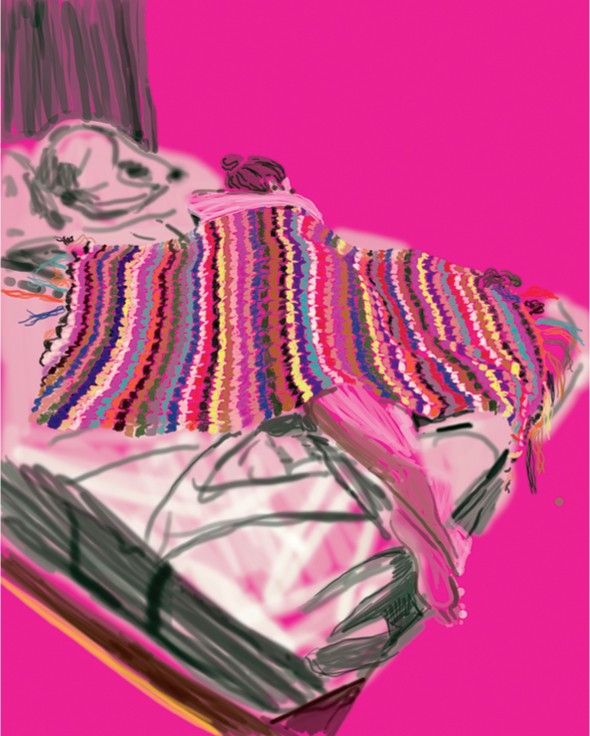Blanket Approval
When Vancouver-based painter Kim Dorland paints his wife and muse, he likes to wrap her in a blanket. There are at least a half-dozen portraits—some outdoors in the forest and others inside the studio—where her body is variously covered or uncovered by a Hudson’s Bay point blanket. The blanket is a sufficiently versatile device to be most revealing when it reveals very little. In a recent Untitled painting, he has draped over Lori a wool blanket woven by his great-great-grandmother in the 1960s. The fringed blanket is predominantly red with the addition of turquoise, yellow, pink and black stripes. It is a case of a loved object covering a loved subject.

Kim Dorland, Blanket, 2017, oil and inkjet print on canvas, 154 x 122 cm. Courtesy Galerie Antoine Ertaskiran. © Richard Max-Tremblay.
The painting’s origins, in contrast, were a reaction to a less than happy event. “When Trump was elected I think we were all freaked out and wondering what does this mean. It was such a surprise that I found myself focusing on more domestic subjects. I was just shutting the world out.” He shuts the world out by opening up the door to intimacy. We see only the back of her head, part of her shoulder, and her left calf and crossed feet. Dorland has done a pair of other paintings in which Lori and this same blanket are pictured in an armchair in the living room; she is naked and the blanket is underneath her. But in Untitled, beneath the material, you can tease out the contour of her body. “There is something beautiful and erotic about the way the blanket shows her form. It’s a more sexualized painting than when she is nude in the chair.”
The painting incorporates familiar technical territory and a new way of working; Dorland is now making inkjets on canvas. “My work has always been about many things collapsing into each other to make a whole, like acrylic, oil, spray paint, glitter, so, for me, this was just another tool in the paintbox.” The problem the inkjet oils present is what to paint and what to print. What interests him are the differences between the two surfaces and the tension they establish. Dorland decided to leave the blanket printed because of the complexity of the interweaving colours, and on the sheets “there is almost a trowelled-on amount of paint.” Underneath it all, there is an underground surface of fluorescent pink. “Instead of just sitting there, the pink makes every other colour scream at your eye.” The other function of the underpainting is to connect him to the aesthetic practice of the city in which he now lives. “Out here a number of wonderful photographers use backlit Cibachromes and this is my way to backlight my own paintings. Those fluorescent colours—pink, orange and yellow—soar out at you due to their visual punch.”

Study for Blanket, 2017. Courtesy of the artist.
Untitled was based on the best of a series of photographs taken in the couple’s bedroom. It shows Lori on a bed that has been angled into the room and is cut off at three points. The top edge shows a roughly painted reddish curtain—the artist calls them “dumb digital marks”— coming up against a back wall with thick layers of scraped grey paint. Dorland admits that the grey “is not the most exciting colour but it works to make the blanket more vibrant.”
Finally, the success of the Untitled painting remains a mystery. “The word ‘alchemy’ comes to my mind,” he says. “I’m standing there with all the tools of my trade; I’ve got my brushes, my scrapers, I can buy high-quality colours, and that’s where the thing happens that I can’t plan for. When you are baffled in a good way by your own paintings, then I think you’re on to something.” ❚

